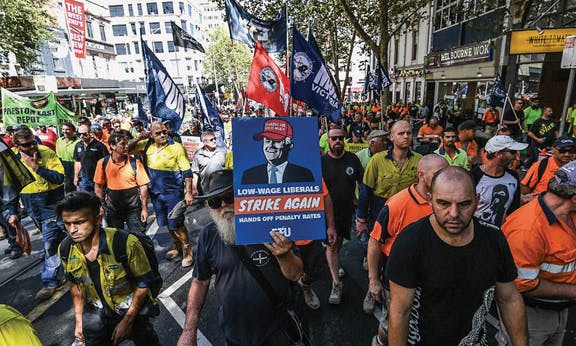How workers won penalty rates

The Turnbull government’s backing of the Fair Work Commission’s decision to slash penalty rates for Sunday and public holiday work is the latest round in a long battle over a key working condition.
The struggle for decent penalty rates in Australia goes back at least as far as the campaign for the eight-hour day in the mid-19th century.
Workers understood that there was little point in gaining a nominal eight-hour day (a 48-hour six-day working week) if the bosses could still compel you to work extra hours of overtime at the standard rate of pay. So they demanded time and a half for overtime in an attempt to limit excessive working hours.
Workers also began to demand and win penalty rates to compensate for especially dangerous, arduous, oppressive or unpleasant work (such as cleaning sewers), for work in confined spaces (such as mines) or for unsocial shift work. Bakers, for example, campaigned for extra compensation for having to work nights.
Major gains were won at the end of World War One, reflecting the tremendous militancy of workers radicalised by the slaughter in the trenches and the sacrifices imposed at home to sustain the imperialist war. In 1919, large numbers of workers obtained a penalty rate of time and a half for “unsocial hours”, i.e. Sunday work.
There were big struggles by construction and engineering workers for a 44-hour week, i.e. a half day off on Saturday afternoons. Those workers in turn won penalty rates for work on Saturday afternoons.
One of the most significant struggles to defend penalty rates occurred in the engineering industry in the late 1930s. In June 1938, the Arbitration Court granted a special award for the Commonwealth Aircraft Corporation factory in Melbourne. The award undermined established conditions and included the abolition of penalty rates for the first four hours of overtime and for repair and maintenance work performed on Sundays.
The workers were outraged. Their anger was further fuelled by the fact that management refused to meet with the main union involved, the Amalgamated Engineering Union (AEU), which had been excluded from the Arbitration Court hearing because it previously had been deregistered for taking strike action.
On 1 August 1938, 200 AEU members, together with members of the Sheet Metal Workers Industrial Union employed by the factory, walked out on strike. The following week, they were joined by all the other unions on the job.
Simultaneously, AEU members in a series of Defence Department plants announced their determination to stop work in sympathy with the strikers. This severely threatened the Conservative government’s attempt to place industry on a war footing.
Six weeks of determined strike action forced the government to compel the Arbitration Court to back down and agree to the workers’ demands. Not only that; the strike forced the court to re-register the AEU.
Deregistration of the union as a punishment for industrial militancy had proven a totally ineffective tactic for the bosses and the government. It had only inflamed the fighting spirit of the rank and file.
Many workers, however, did not receive penalty rates for Saturday work until after World War Two. As in the First World War, the war encouraged a radical mood. After all the sacrifices they had made, workers were determined to achieve a better world and avoid a return to the terrible depression years of the 1930s. A huge wave of struggles over an immense array of issues swept the country during the last two years of the war and in its immediate aftermath.
One of the key demands was the 40-hour week, which was spearheaded by a 13-week strike in 1945 by commercial printers in NSW. Their victory flowed on to most of the rest of the workforce. Then, in 1947, the Arbitration Commission was forced to extend weekend penalty rates to Saturdays, while Sundays were set at double time.
Appallingly, some groups of workers – firefighters, rural workers and domestic servants – were exempted from the NSW legislation granting the 40-hour week. NSW firefighters, who were condemned to remain on a 56-hour week, subsequently oscillated between campaigns for a 40-hour week and for extra pay, time and a half for Saturday work and double time for Sundays.
After a long campaign, legislation granting the 40-hour week for NSW firefighters was passed in March 1955. But it contained all sorts of loopholes that allowed the bosses to get the Industrial Commission to order the firefighters to work an extra eight hours of compulsory overtime without penalty rates.
As soon as the decision was announced, the afternoon shift walked out in protest. An angry mass meeting voted 600 to 40 for an all-out strike. After five days facing threats of fines and deregistration of the union, the union officials managed to get the strike called off for an unsatisfactory compromise settlement – a 42-hour week with two hours’ overtime.
The bosses have consistently fought to restrict or roll back penalty rates.
The Howard government’s 2005 WorkChoices legislation opened the floodgates for the undermining of penalty rates. By April 2006, 63 percent of the Australian Workplace Agreements authorised under WorkChoices had removed penalty rates.
The subsequent Rudd/Gillard Labor government refused to rectify this situation. Indeed, it established the Fair Work Commission that carried out the latest attack.
The lesson from more than 150 years of history is crystal clear: we can’t rely on governments or the courts to defend basic conditions like penalty rates. Only determined industrial action offers any hope of defeating the bosses’ agenda.